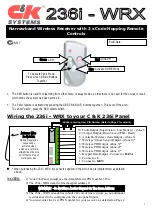
52
SD Series Technical Manual
MDS 05-4846A01, Rev. F
•
Listen Before Transmit
—Used to activate or deactivate LBT when
this feature is authorized in the radio.
•
LBT Behavior
—LBT can be configured to behave in one of two
ways; either
listen on the radio’s transmit frequency (TX)
or
listen
on the radio’s receive frequency (RX)
. Typically, Remote radios
are configured to
Listen on RX
(the default selection) to avoid col-
lisions with the Master unit. In peer-to-peer configurations,
Listen
on TX
may be preferred. Optimal choices depend on the data trans-
mission characteristics of the connected system.
•
Min/Max Channel Wait
(ms)—These settings refer to the time period
(in milliseconds) to wait after the channel is free before transmis-
sion is allowed.
Minimum wait time:
Normally, the minimum channel wait time
should not be changed from its default setting of
0
ms unless per-
forming advanced operations, such as staggering the responses
from multiple Remotes.
Maximum wait time:
Normally, this setting should not be
changed from its default of 100 ms unless performing advanced
operations. Some examples of when this may be beneficial
include:
• There is a need to stagger responses from several Remote
radios.
• The transmission latency from the time the channel is free is
too high, in which case a lower value can be entered.
• Collisions over the air are too high, in which case a higher
value can be entered.
NOTE:
The lower the value of the Maximum Wait Time, the higher
the chances of collisions occurring over-the-air. Conversely,
the higher the value of the Maximum Wait Time, the higher the
transmission latency.
•
Timeout (ms)
—Provides a setting for the maximum time to wait (in
milliseconds) for the channel to become free. When this time is
exceeded, the radio follows the action defined in the
Packet Action
on Timeout
setting (either
Drop
or
Send
).
















































